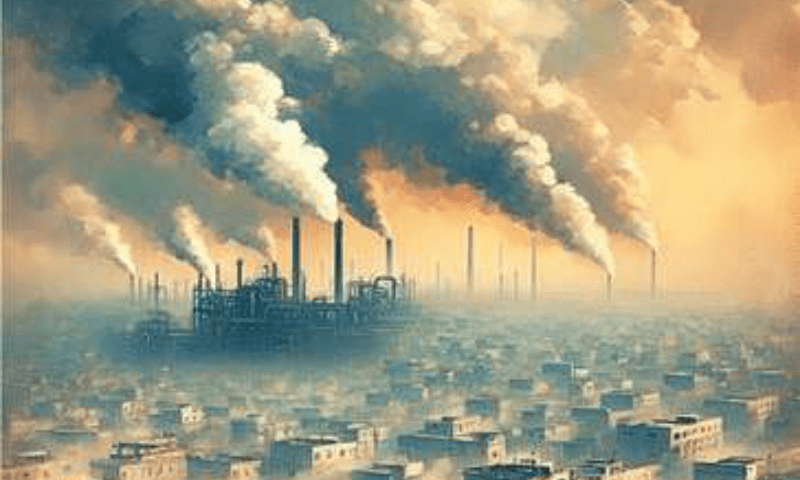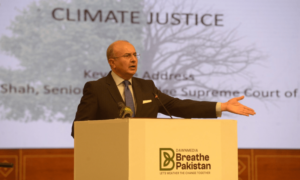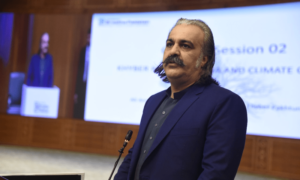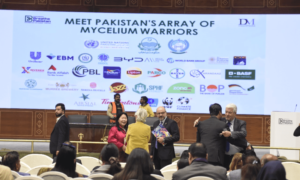THE future is never quite what we expect it to be, but climate trends have redefined our lives as unpredictable, volatile and often red in tooth and claw.
Yet if one thing is certain for all of us in Pakistan, it is the reality of extreme weather and “global boiling”. It cannot be wished away or denied. It cannot also be left to policies on paper which tick the right boxes. If legacy media like Dawn is finally ready to put our capacity to ‘Breathe’ front and centre, then we are at least on the journey to making both public and policymakers understand the compelling gravity of this existential meta-trend.
Because Pakistan’s climate trendlines are linked to global trendlines, despite our tiny carbon footprint, our natural and climate capital has gone from green to red. Our monster monsoon in 2022 made us the ground zero of climate-induced catastrophe, with a clear link to rising global warming and growing emissions.
Since then the world has seen a horrific series of hellscapes unfold in apocalyptic reels on social media. What went on in Pakistan in 2022 did not stay in Pakistan. Obviously what went on in Los Angeles last month will not stay in Los Angeles either. That is the intrinsic nature of this beast. To plan ahead for 2047, Pakistan should not just learn from the present, but also model all plans on possible futures that rely on business as usual (BAU) models of climate action. What would happen in a BAU scenario and what would happen with accelerated action. While climate justice dictates that we identify the world’s biggest emitters as the culprits, the fact that our house is burning necessitates a clear rethink of what we need to do to put out the fire.
THE BUSINESS AS USUAL SCENARIO: 2047
In the different futures ahead of us, the fear of parched earth, the melted glacier, the desertified delta, and the scorched mountain need to be kept in mind to drive action and to make difficult choices.
If one truth is established in our climate reality, it is that Pakistan is a poster-child for the scale and level of the triple planetary crisis that brings climate change, biodiversity loss and pollution into a graphic everyday reality for most of our population. It is almost as if on a bad day, we are fighting on all fronts, especially given the level of resilience needed to survive the millennium.
BAU means Pakistan will be unprepared and under-resourced for the extremes in weather and water volatility that climate stress may bring to our doorstep. Policymakers already know that Pakistan’s relationship with the climate crisis is defined by extreme vulnerability. They also mostly realise that the responses needed are equally beset by gaps in knowledge, capacity, coordination and access to international resources.
Given the global pace of inaction, with rising GHG emissions, and the Paris goal of keeping 1.5°C alive dead in the water, rising temperatures will put Pakistan at risk in more ways than one.
Given a projected temperature spike of 2.5-3°C by 2047, the most catastrophic impacts will be prolonged heatwaves and water shortages. With our glaciers melting at unprecedented rates, the country will risk losing 60pc of our water resources, especially since the Indus River System is largely glacial fed. This will not only impact the availability of the water in the basin, but also lead to higher sea ingress and desertification of the already-stressed lower riparian delta areas.
PAKISTAN MUST WORK TOWARDS DEVELOPING INNOVATIVE HOME-GROWN SOLUTIONS DRIVEN BY A PROACTIVE MULTI-SECTORAL APPROACH.
At the same time, with population growth at the current rate, the BAU scenario will lead to a 40pc surge in the demand for water. This will likely be the worst catastrophe, leading to serial instability and shortages for livestock and agriculture, not to mention the pressure on rapidly growing urban centres for safe drinking water.
The competition between riparians may well spiral into conflict because scarcity will trigger a series of downstream disasters on agriculture, pastoral lands for livestock, migrations, drinking water shortages and energy generation. Given that crop yields could decline by up to 50pc, food security will also define the frontline of Pakistan’s climate vulnerability.
Ultimately, climate change is as much about the planet as it is about people. Under the BAU, or pessimistic scenario, poverty could therefore shoot up by 30pc, forcing up to 21 million more people into a cycle of serial deprivations. Given that we have 40pc of Pakistan’s demographic under the poverty line already, this will turn Pakistan’s future into the red zone of climate impacted dystopia.
Because poverty levels and access to social entitlements have a direct bearing on how communities survive climate induced impacts and bring resilience to rebuilding their lives, the impacts may well set large swathes of a growing population totally off all indices for progress, sweeping them backwards into hardscrabble subsistence including the low bar of crucial nutrition deficits. The fallout of climate stress is well known to be inequitable, so women and children, especially under the age of five, will feel the shocks not just disproportionately, but disastrously. For a country where stunting in children under the age of five has already reached crisis proportions at a staggering 40pc, due to malnutrition, the ability of families to change this toxic reality will be hugely compromised.
Any resilience indicator will also testify to the fact that if literacy is impacted, which is currently the case in arid and flooded climate hotspots, especially in terms of transportation to schools for girls, the fragility of households with 26 million children out of schools will not just put them on the frontlines of destitution and zero social mobility, but also the country on a perilous tipping point of losing all chances of building human capital for a huge demographic of 50-60pc under a median 30 years of age by 2047. Projections at the current population rate suggest a surge in working-age population migrating to seek opportunities in urban areas, which will further be under stress for better infrastructure, municipal services and housing.
In the strategic drift scenario, where cities grow without robust solid waste management, with growing plastic-choked landfills and waterways, a series of climate events can easily place all in-migrants in under-serviced and poor areas in foetid squatter settlements, breeding further unsanitary crowding and health crises. The need for transport, sustained energy supplies, quality public healthcare, digital connectivity and clean water will only grow as a young, restless demographic starts seeking entitlements while jobs will only likely grow in sunrise sectors, such as technology, media and entrepreneurship. The social impacts could well result in Pakistan’s young ‘bulge’ demographic morph into a volatile mix of radicalised cohorts possibly finding shelter in criminality and violence.
Without active disaster risk preparedness, including early warning systems, women in rural areas will suffer the invisible rigours of exclusion, unmet health needs and predation, as they did in all conflict and climate displacements, especially 2022, where 650,000 women were in different stages of pregnancy without any prospect of immediate healthcare or emergency services. Even with optimal health services, it is important to remember that no country, especially Pakistan, has been designed for the volatility that monsoon and flooding, or heatwaves can now bring to a planet off its balance.
If urgent plans to combat heat acceleration, water and food stress are not met, the worst case scenarios will also have a domino and amplification effect. Without much more scaled up disaster risk reduction plans in place for each province, and each district, one big climate event could push development gains of a decade within ten days. At current rates of BAU, without transformational investments in agriculture, energy and water usage, sectoral GDP in both agriculture and industry could decline by 17pc by 2047.
For perspective, the 2022 flood caused an 8pc drop in GDP, while a 9pc impact would be enough to completely undo hard fought gains on poverty reduction. The annual economic output could see a cut of 18pc due to climate risks, such as heatwaves and floods. Air pollution, Pakistan’s serial killer, impacting many of our cities with unbreathable air quality, would have its own economic impacts on the GDP by 4pc. These are big numbers with amplified downstream impacts on growth, resources and human health.
At the macro level, where the exogenous shock of climate events married with high debt liabilities forces crippling rents on the poorest, the costs of inaction and slow reform can spiral to a quantum level. While no prognostications can be final, it is worth looking at a broader view of climate stress, in which projected annual climate related damages could reach $20 billion per year. This is a big number, which could set the country off path in terms of climate, development and economic goals of middle power resilience.
We will have to move forward with creative home-grown climate financing, which is not unavailable if the regulatory climate and enabling ecosystems create a taxonomy of incentives. Most of our solutions will have to be local.
According to the World Bank, which estimates Pakistan need at a staggering $348 billion to stay on a trajectory of sustainable health just by 2030, it is clear that financial and debt distress could well add yet another layer of stress on a country in deep public and energy sector malaise. Some estimates suggest that by mid-century the level of climate shock Pakistan could face could be as high as $1.3 trillion.
THE ACTION ALTERNATIVE
None of the above needs to be inevitable, let alone imminent. Before anything, Pakistan needs to declare a climate emergency, not as a point to panic about, but as a serious whole-of-country call to action.
Pakistani cities in the south now regularly hit 50°C every summer, with some, like Dadu and Jacobabad, touching 53°C, making them the hottest places on the planet. This is neither understood nor absorbed at any level as a big ticket red alert, because of the cognitive disconnect our public sector has with climate action. For perspective, the United Kingdom declares a climate emergency when its cities hit 40°C. This needs to change. The crisis is real, and it is existential. All departments across the country have to start aligning their budgets and public investments with climate tags and climate-proofed investment plans, if the urgency is understood.
Pakistan needs actions instead of just announcements.
Second, any vision for Pakistan at 2047 should be based on the sober reality that between stated plans and actual action, especially in a dramatically varied mountain to delta terrain like Pakistan, there is often too many an unaffordable slip between paper and outcome. Moving past the burning mountain and the cracked soil will not only need pro-active multisectoral coordination throughout the year, but also provincial alignments in order to bridge the horizontal and vertical fissures in policy action. At all levels, and especially so for climate delivery, a high level war will have to be declared on the silo-turf entrenchment that has embedded itself like a hookworm in our institutional ecosystem, because it kills both innovation in the private sector and real outcomes in the public sector.
Example: coordination barriers block key intersectoral actions, especially when institutional conflicts arise. Yet even for carbon neutrality, despite the fact that integrated responses are the only way some targets will be realised in a coordinated net zero platform with the private sector, the latter remain out of the public policy loop without a framework for climate-smart manufacturing, decarbonisation incentives, climate taxonomy, supply chain reporting benchmarks, and even policy alignment for a looming barrier of carbon border adjustment tariffs from the European Union.
Given that Pakistan’s Nationally Determined Contributions (NDCs) are as ambitious as some developed countries, they can easily be fulfilled if the private sector is involved in strategic planning. Involving the transport, energy, power and petroleum sectors is key. Yet even for the electric vehicle (EV) transition from the old combustion engine, coordination between local industry, importers and a slew of federal ministries remains unfocused and adrift, which can easily be changed. Just fixing the transition ecosystem for electricity driven vehicles, like two- and three-wheelers, will dramatically transform the emissions and local pollution crisis. Blue skies will come right back.
By the same argument, on renewable energy, the private sector and consumer is ahead of the government.
Pakistani communities have led the way in transitioning to solar energy in what is known as the great solar rush, where one-third of Pakistan’s installed capacity worth of solar panels has been imported from China in just one year to give people affordable, sustained, low-cost electricity. It is now the policy regulator which must catch up to manage the unintended consequences of too much electricity in the system.
On policy, the vision of a green Pakistan and its ambitions already exists on paper, while all the provinces have welldesigned climate policies that tick all the right boxes. What the country needs to resolve most urgently and radically is its relationship with water, as much as with species, nature, land and air. With a polluted coastline and a river that has been its lifeline for a century, the water scarcity risk of 2025 needs to be taken seriously. As does the fact that the Indus River Basin and its aquifers are fast depleting, while the Indus River itself has become toxic with man-made effluent and the debris of human consumption. It is now the second most polluted river in the world.
Again, while UN agencies rush to assist Recharge Plans, the harsh truth is that none of them can have transformational impact. Because Pakistan’s water crisis is past incremental actions, a Blue Pakistan Policy needs to be actionalised along with Green Pakistan one. One sector cannot revive or breathe without the other. Green and Blue Pakistans need to align their visions in our terrain for an alternate future of water and food insecurity.
Building early warning systems, water telemetry to reduce competition, and changing water consumption habits per capita will be key to life in 2047 if Pakistan is to retain the advantage of one of the largest man-made irrigation systems in the world. Right now, we may be the fifth most climate-vulnerable country in the world, but we are also in the list of the 10 highest consumers of water per capita in the world. This view of water as an infinite resource needs to change.
Further, the country needs to decolonise even its most local climate responses. In almost every federal office, civil servants and policy communities expect well-meaning international agencies to suggest responses and even projects, with no clearly defined asks to move assistance in the right direction. This makes for a crippling intellectual dependence on multilateral agencies, who in their best intentions welcome home-grown plans that are owned by policy elites as well as communities, but rarely even get project asks from the relevant departments.
In the context of drying up foreign aid pools, priorities need to be set by country agendas, on an order-ofbusiness scale of needs that unlock local potential as much as global green financing. This means we need to stop waiting for someone to tell us what to do, or which international imperative to guide our path. That era is over, at least for now, and in times of global fragmentation, whatever national response we need to muster to an accelerated climate polycrisis must be redesigned for local environments, topographies and development contexts as adaptation that is fit-for-purpose.
Adaptation and resilience, therefore, need to emerge as key priorities for surviving the century, because the heat impacts of climate change are too ferocious and fast for us to wait for big emitters to switch off GHG emissions.
In this policy, we need to add Adaptive Social Protection as a core institutional peg in our disaster risk reduction wheel. This will cater to targeted protection for vulnerable communities for enabling resilience as a lifesaving set of changes to work and social habits. Resilience should become the new development and planning filter for all spending decisions, but not just for infrastructure. It should be aligned and embedded into all planning for climate resilient crops, water and cryosphere conservation, disaster risk reduction and management systems, reforestation cover, urban sanitation, air and land pollution, as well as energy transition in affordable steps. The global trajectory for emissions is clearly set for extreme weather, and to face that, our population must be enabled to develop antifragility strategies for the coming unpredictability.
In building local resilience, innovation must be encouraged at the incubator level where start-ups across the country are working with local low-cost solutions for plastic as well as air pollution, but find little support to patent or scale up any products or processes needed. For example, even if crop burning in the Punjab continues to be impacted by Indian wind patterns and toxicity, alternatives will have to incentivise farmers as opposed to penalising them. And incentives will once again need coordinated investments in research and development (R&D), which is the only path to change in a science-led transformation in a knowledge-based future.
Also, given the Darwinian nature of international climate finance, which often serves the fittest not the most fragile, country capacities need to be built up for projects to be accepted, raise equity and reach financial close. Financing and governance capacity both will be a bottleneck for surviving mid-century climate trauma for all frontline states that seek to scramble out of the heat-induced hole of recurring extreme weather. To avoid plunging into multisectoral distress, significant interventions will be needed in a cluster of smart development outcomes for the most reduced estimated outlay of $ 3.8 billion annually, according to the World Bank, if the country moves with speed and coordinated agility to align vision with executive actions.
Regaining space, or money owed as part of a loss-anddamage bargain will not be achieved by routinised responses, so it is important that Pakistan seek financial and technical support by leveraging bold and clear asks. To accompany the reporting update that makes up a country’s NDCs path to carbon neutrality, in COP29 Pakistan put forward a new big idea. That was seeking Internationally Determined Contributions (IDCs) from the global community which has been adept at avoiding commitments that transfer resources for resilience to the developing countries.
Pledges and promises since 2019 have missed their mark by billions of dollars, and today the countries most damaged by fossil fuel emissions are told that despite their low carbon footprint, they must come out of their institutional sloth and present bankable projects to the market, or bring more debt to bear on overburdened economies. This must change if we are lead on climate justice at multilateral forums.
Expecting the carbon trade to change the game is not going to be easy, although Pakistan’s natural capital is already being unlocked and monetised by Sindh in one of the largest mangrove restoration projects. Pakistan will have to move forward with creative home-grown climate financing, which is not unavailable if the regulatory climate and enabling ecosystems create a taxonomy of incentives.
Most of our solutions to survive the future will have to be local, because no one is coming. The action alternative is entirely in our hands.
The writer is a Senator who has formerly been the Federal Minister for Climate Change Environmental Coordination.
- Desk Reporthttps://foresightmags.com/author/admin/











